https://creativecommons.org/publicdomain/zero/1.0/https://www.rawpixel.com/image/9976766

Identifier: shortcourseinast00kidd (find matches)Title: A short course in astronomy and the use of the globesYear: 1871 (1870s)Authors: Kiddle, Henry, 1824-1891Subjects: AstronomyPublisher: New York, Chicago, Ivison, Blakeman, Taylor & co.Contributing Library: The Library of CongressDigitizing Sponsor: The Library of CongressView Book Page: Book ViewerAbout This Book: Catalog EntryView All Images: All Images From BookClick here to view book online to see this illustration in context in a browseable online version of this book.Text Appearing Before Image:when illuminated by the sun,are called opaque bodies ; while the sun, giving light ofitself, is called a luminous bod//. 51. There are, therefore, two kinds of planets, namely,those that revolve around the sun only—called PrimarmPlanets, and those that revolve around the primaries andwith them around the sun—called Secondary Phind*, orSatellite*. Of the latter the moon is an example ; sinc^jas is proved by its apparent motions and ) b isrevolves around the earth every month, and accompaniesthe latter in its annual motions around the sun. 52. Comets also revolve around the sun, but differfrom planets not only in their appearance but in thedirection of their motion, and the shape of their orbits. 50. What do the apparent motions of the planet* indicate ? What does the tele-scope reveal ? What are opaque bodies ? Why is the sun called a luminous body ?51. IIow many kinds of planets are there? What example is given? 52. IIow docomets differ from planets ? What is the orbit of a body ?Text Appearing After Image:.~>2 THE SOL AR SYS TEM. For while the planets revolve from west to east, and inorbits nearly circular, comets sometime? 1 evolve from eastto west, and in very elongated orbits. By the orbit of a body is meant the line which it may beconceived to describe in revolving around some other body. 53. It will thus be seen that the apparent motions ofthe sun, planets, and stars are explained by supposing,1. That the earth is exactly or nearly a sphere; 2. Thatit turns on its axis once every twenty-four hours ; 3. Thatthe earth and all the other planets revolve around thesun ; and, 4. That the stars are situated at an immensedistance from the sun and planets, in the regions ofspace,—a distance so vast that their movements witlirespect to the earth and to each other cannot generallybe discerned. The sun with all its attendant bodies constitute theSolar System. This arrangement of the sun in the centre with the planetsrevolving around it, is sometimes called the Copernican System, fromNichNote About ImagesPlease note that these images are extracted from scanned page images that may have been digitally enhanced for readability - coloration and appearance of these illustrations may not perfectly resemble the original work.
Original public domain image from Wikimedia Commons
Public DomainFree CC0 image for Personal and Business use